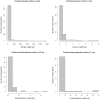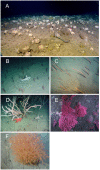Kernel density surface modelling as a means to identify significant concentrations of vulnerable marine ecosystem indicators
- PMID: 25289667
- PMCID: PMC4188592
- DOI: 10.1371/journal.pone.0109365
Kernel density surface modelling as a means to identify significant concentrations of vulnerable marine ecosystem indicators
Erratum in
-
Correction: kernel density surface modelling as a means to identify significant concentrations of vulnerable marine ecosystem indicators.PLoS One. 2015 Jan 21;10(1):e0117752. doi: 10.1371/journal.pone.0117752. eCollection 2015. PLoS One. 2015. PMID: 25607547 Free PMC article. No abstract available.
Abstract
The United Nations General Assembly Resolution 61/105, concerning sustainable fisheries in the marine ecosystem, calls for the protection of vulnerable marine ecosystems (VME) from destructive fishing practices. Subsequently, the Food and Agriculture Organization (FAO) produced guidelines for identification of VME indicator species/taxa to assist in the implementation of the resolution, but recommended the development of case-specific operational definitions for their application. We applied kernel density estimation (KDE) to research vessel trawl survey data from inside the fishing footprint of the Northwest Atlantic Fisheries Organization (NAFO) Regulatory Area in the high seas of the northwest Atlantic to create biomass density surfaces for four VME indicator taxa: large-sized sponges, sea pens, small and large gorgonian corals. These VME indicator taxa were identified previously by NAFO using the fragility, life history characteristics and structural complexity criteria presented by FAO, along with an evaluation of their recovery trajectories. KDE, a non-parametric neighbour-based smoothing function, has been used previously in ecology to identify hotspots, that is, areas of relatively high biomass/abundance. We present a novel approach of examining relative changes in area under polygons created from encircling successive biomass categories on the KDE surface to identify "significant concentrations" of biomass, which we equate to VMEs. This allows identification of the VMEs from the broader distribution of the species in the study area. We provide independent assessments of the VMEs so identified using underwater images, benthic sampling with other gear types (dredges, cores), and/or published species distribution models of probability of occurrence, as available. For each VME indicator taxon we provide a brief review of their ecological function which will be important in future assessments of significant adverse impact on these habitats here and elsewhere.
Conflict of interest statement
Figures










References
-
- FAO (2009) International Guidelines for the Management of Deep-sea Fisheries in the High Seas. FAO, Rome. 73p.
-
- Fuller SD, Murillo Perez FJ, Wareham V, Kenchington E (2008) Vulnerable Marine Ecosystems Dominated by Deep-Water Corals and Sponges in the NAFO Convention Area. Ser No N5524. NAFO SCR Doc 08/22, 24pp.
-
- NAFO (2008) Scientific Council Meeting 22–30 October 2008. Ser No N5594. NAFO SCS Doc 08/26, 32p.
-
- Murillo FJ, Kenchington E, Sacau M, Piper DJW, Wareham V, et al... (2011) New VME indicator species (excluding corals and sponges) and some potential VME elements of the NAFO Regulatory Area. Ser No N6003. NAFO SCR Doc 11/73, 20 p.
-
- NAFO (2012) Scientific Council Meeting –2012. Ser No N6072. NAFO SCS Doc 12/19, 215p.
Publication types
MeSH terms
LinkOut - more resources
Full Text Sources
Other Literature Sources

